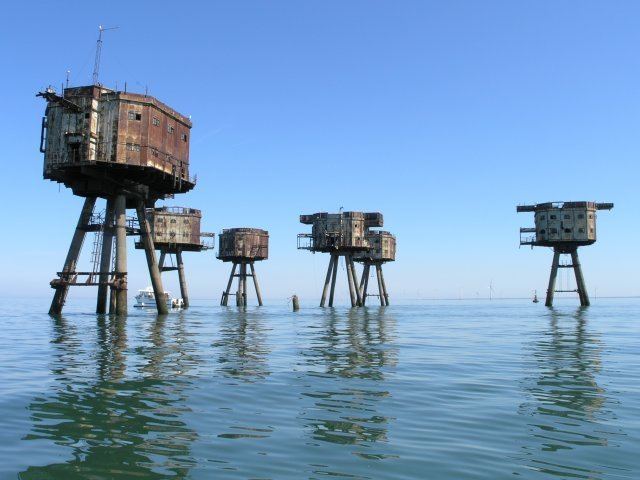 | ||
Radio City was a British pirate radio station broadcasting from Shivering Sands Army Fort, one of the abandoned Second World War Maunsell Sea Forts in the Thames Estuary.
Contents
Origins
In 1964, following the launch of Radio Caroline, Screaming Lord Sutch said he would start his own station. On 27 May Radio Sutch began broadcasting on 194 metres (announced as 197), 1542 kHz, from the south tower of Shivering Sands. It was a low-powered, low-budget operation. The transmitter, from a Handley Page Halifax bomber, was powered with a cascade of car batteries, a scaffold pole with a skull-and-crossbones flag as an antenna. By September 1964 Sutch had become tired of it and sold it to his manager Reginald Calvert for a reported £5,000. Calvert bought new equipment and expanded the station into other towers. One of the original seven towers had been destroyed when a ship collided with it, leaving the northernmost tower isolated. The remaining five were connected by catwalks in an irregular star shape. Calvert's team repaired the catwalks and refurbished the facilities and living quarters. New studios were built, a more powerful transmitter installed, and the station experimented with new antenna configurations and frequencies (1034 and eventually 1003 kHz). Initially antenna wires were strung around the periphery of the towers. This was unsuccessful due to poor insulation. Later a vertical mast was erected on the central tower, supported by guy wires on three of the surrounding towers, and the station adopted the nickname "your tower of power". Although output never exceeded 2 kW, the efficiency of the antenna combined with its location over water (a reflector of radio waves) gave it the coverage of a more powerful land-based station, and Radio City claimed a power of 10kW for the purpose of attracting advertisers.
Studio equipment
The studio equipment was standard albeit low-budget, comprising a pair (later three) of Garrard turntables, an AKG D12 microphone (the same model used by both Radio Caroline ships, Radio London and Radio 270), domestic tape decks and a basic custom mixer. A US navy transmitter General Electric TCJ-7 (nicknamed "Big Bertha") replaced the bomber transmitter, instead of the makeshift scaffolding pole antenna, a real antenna mast was used. Most stations played jingles and commercials from cartridges but City used reel-to-reel. In addition to the usual music programmes, subsidised by Dutch and American evangelical shows, City had the only comedy show on pirate radio - The Auntie Mabel Hour, recordings of DJs acting comic sketches and parodying contemporary songs. Some material seems to have been stolen from The Goon Show and Round the Horne. At Christmas 1966 the show featured a parody of Alice in Wonderland and included the DJs singing new comic lyrics to instrumental versions of popular songs.
Another novelty was The Anti-City Show, which invited listeners to send letters and reel-to-reel tapes of complaint about the station. It became a forum for complaints about anything that annoyed. Occasionally, "You've Got Your Troubles" by The Fortunes was broadcast as a signal to land-based associates of a problem, such as a supply shortage.
The Port of London authority had placed wind and tide gauges on the isolated north tower and complained that City's signal interfered with their radio link to the mainland, potentially placing shipping at risk. Interference with official communications was a commonly cited reason for pirates to be banned but Radio City was to provide a more compelling reason for their closure.
Merger talks and death of Reg Calvert
In September 1965, merger talks began between City and Radio Caroline South. A transmitter was delivered to the fort, intended to be used by Caroline when it left its ship. The merger collapsed, and the transmitter was never paid for. Calvert then talked to Radio London about a merger, in a venture called UKGM (United Kingdom Good Music).
In the early morning of 20 June 1966, a business associate of Calvert, retired Major Oliver Smedley (who claimed ownership of the transmitter), sent men to take possession of Shivering Sands. That evening, Calvert visited Smedley's home and in a scuffle was shot by Smedley. Smedley was charged with murder but cleared on grounds of self-defence.
The killing spurred the Government to shut offshore stations, passing the Marine Broadcasting Offences Act. However prior to this legislation, it was established that the fort, within British waters, was covered by existing legislation. On 8 February 1967, at midnight the station closed.
